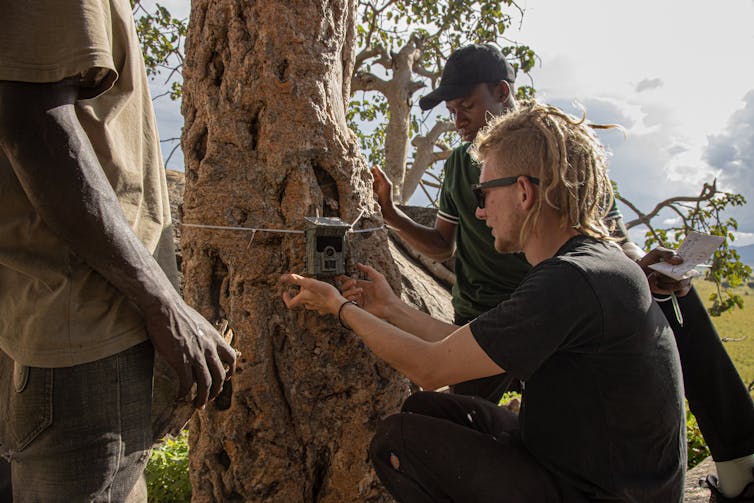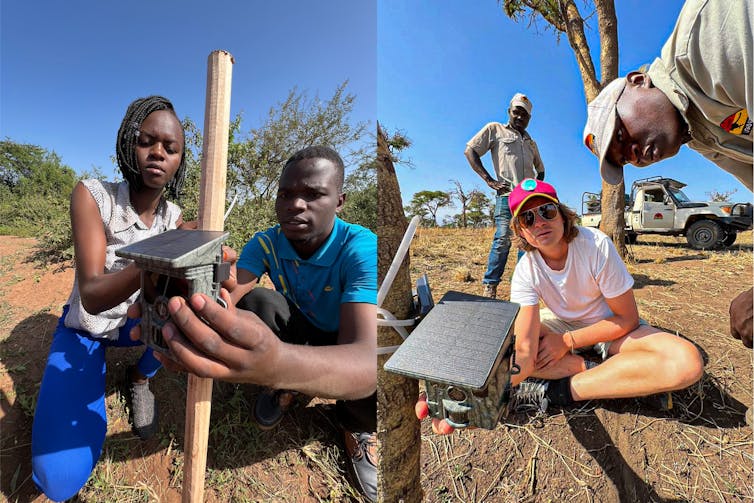(Photo of Eric Lafforgue / Art in Corbis through Getty Imags)
For about 15 years, almost no information was available in the status of Ugandan’s great foothills, including the population in the largest national park.
These species represent a critical part of Ugandan’s growing tourism economy. Country is home for the famous tree climbing lions that are very searchable for this unique behavior. Together, lions and leopards arise Ten thousands of dollars each year From Safari reviews and allied activities.
Keeping an eye on the words of proverbs could not be more critical for the country. When the wildlife is not seriously monitored, cats may not disappear like tigers for several years Sariska Tiger reserve in India.
However, many human monitoring of conservation rejects. They claim that the “bean meter” approach to protection Review the funds and actions saves the animals. Others just say that this is a something difficult to do on scale Especially natural for animals that are naturally shy (in many countries) and very low levels.
In a relatively small African country – Uganda In ranks 32 How much is enough to see how the populations of carnivists are upset by 54 countries? This has been the problem of our work, which has been in Uganda, has been following African lions, leopards and spotted hiones for ten years.

Our last two studies Murchison Falls and Six protected area The country sought to solve the problem by drawing and working on a large local and international specialists living in Uganda.
Uganda Government to work with the research and monitoring group in the Uganda Wild Natural Organization, independent scientists, government guards, university students, lodged owners, lodged owners, lodged owners and the country’s main savanna parks and set out to determine conservation managers and bring together.
We hope to cover more grounds with people and organizations that will not work together. Many of these people need science and field skills needed to build strong, long-term monitoring programs for wildlife, which threatens many of these individuals for the first time.
The result is the largest, most comprehensive number of African lifers, leopards and spotted horns.
We found the spotted stripes to do better than we expected. However, the lions are declining where the conservation efforts are where the direction is. In addition, our number proves the value of cooperation when the information that can help save animals.
Our unique approach
Was inspired by Kenya First, national, science-based survey The first important step of the Aslan and other carnivors in key resources was to ensure the cooperation of the research and monitoring department of the Uganda Wildlife Organization.
Together, we have identified the stakeholders of critical conservation in and around the six protected areas. These are Pian Upe Wildlife Reserve, Kidepo Valley, Toro Semliki, Mburo, Queen Elizabeth and Murchison Waterfall. The leopard and hiyenations occur in some other parks (such as Elgon and Rwenzori National Park), but the resource restrictions prevented these sites prevented.
Only in our cereal surveys, there was nothing to ask for what we wanted to live closest to these species in the room.
We briefly listed the university students, independent scientists, university students of Kampala, NGO staff, NGOs and even cup hunters, independent scientists and university students. All came together for a few days to find carnivores in each landscape, find out how to find detection dates and analyze the data.
Five technical workshops showing participants, how are the landscape in the landscape with the maps with the maps of how they drove African lions.

We also trained Participants:
- How to define the lions of high-precision photos How to determine whirler spots – these are small spots where a cat’s beaters occur in cheeks
- Leopard’s and Spotted Hyena’s body can be identified in the pictures of the camera trap pictures
- Data collection analysis methods
- It is a technique to assess the densities and abundance of the population.
More than 100 Ugandan and international cooperation are more than 26,000 km, and in January 2022 in January 2022 in January 2022 in January 7.516 Camera Trap Nights
Our scientific approach focused on how to achieve the best number of the best mumnivors. We have set some of them in the process The greatest drawbacks of previous studies. Double counts can not combine individual animals and the possibility of discovering. The more worse, simply adds all the visual animals and did not create any local levels.
The results
As expected, our results took a sad picture in some areas, but the hope of others.
- In the magnificent Murchison Falls National Park, Nile River worked in the east-west, we estimated that about 240 cars were left around the area of about 240 oscillations. This is the highest and at least five to 10 times highest than in Uganda and Kidepo and Queen Elizabeth parks.
- In the Queen Elizabeth National Park, in the house of the lions of the lions, more than 40% of 40% (39 people in 39) have been recorded since the last questionnaire In 2018.
- In the north of the country, the best assessment in the Kidepo Valley, only 12 individual lions between 1,430 km ², compared to 132 Previous assessment of the lion applied about 15 years ago.
On the contrary, leopards demonstrate strong populations with high densities of high densities in the selected areas, Muro and Murchison waterfall. Pian upe and Queen Elizabeth’s Ishasha sector recorded the lowest density.
Stained hienas they have proven to be stronger. Sites in the survey occur from 6,15 to 45.31 / 100 km mentally. In Queen Elizabeth, the number of them can increase as pressure reduced the reduced competition due to reduced competition.
These findings emphasize the urgent need for conservation interventions targeted for lions, especially in the fighting populations of Ugandan.
Value out of numbers
Our approach has shared the collection of information and gave people an opportunity and skill to deal with the science of wild nature.
For many conservationists in the country, this was the first chance to be the author in a scientific document (a component of more graduate schools).
Many people, who are not satisfied with how to save great carnivors in Uganda, have a hand for collecting and intended for it.
Since we accepted a completely scientific approach, we also recognize our research improves over time.
General Manager, General Manager, research and monitoring in the Wildlife Organization in Uganda helped the investigation into the establishment of this article.
This article first appeared Conversation.








